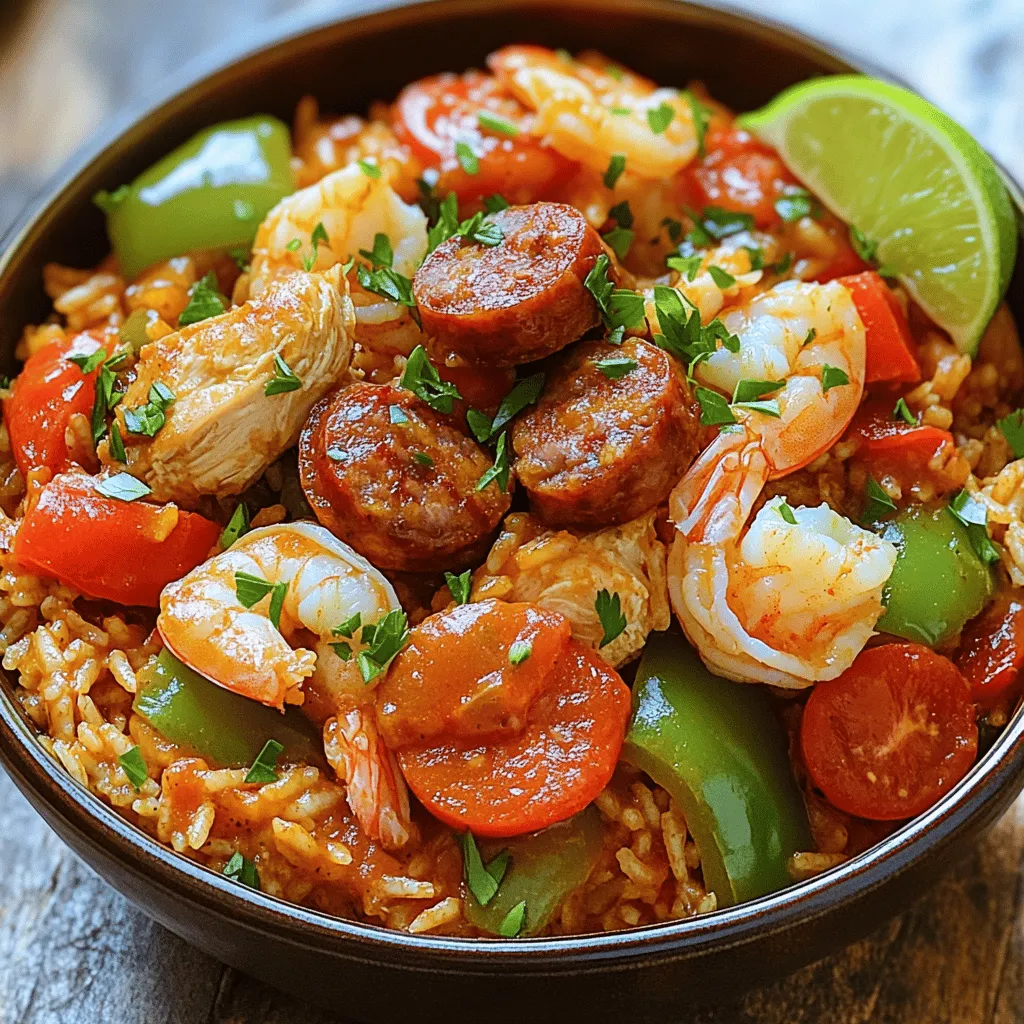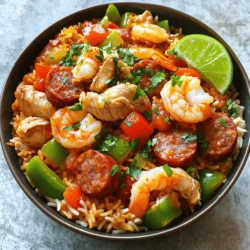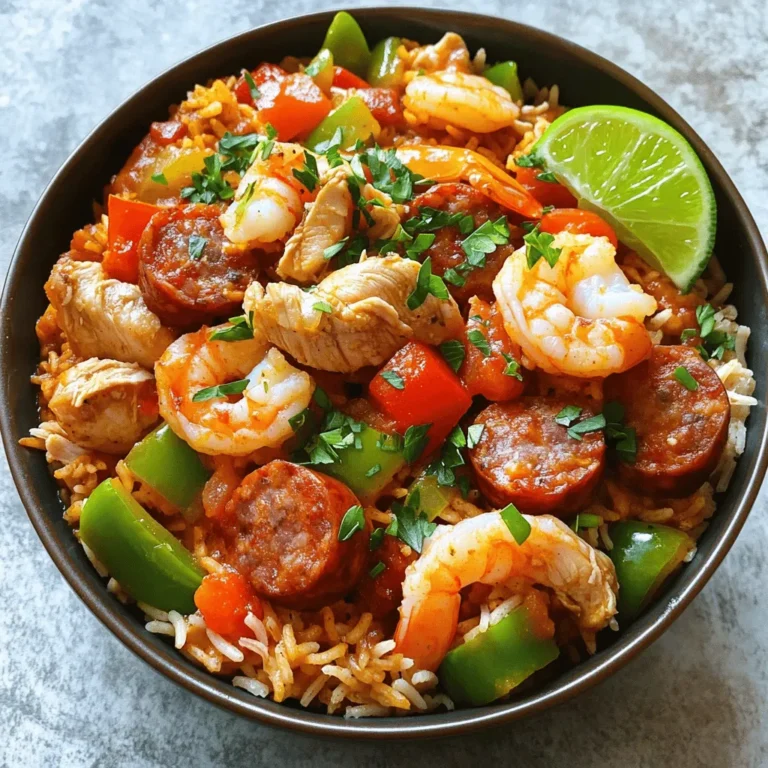Craving comfort food? You’ve picked the right recipe! My Delicious Jambalaya combines chicken, sausage, and shrimp with rich spices. This dish bursts with flavor and warmth. Whether feeding a crowd or treating yourself, it’s easy to make. In this blog post, I’ll guide you through every step, share tips, and even suggest delicious variations. Get ready to bring a taste of Louisiana to your kitchen! Let’s dive in!
Ingredients
List of Required Ingredients
To make a great jambalaya, you need a mix of proteins, veggies, and rice. Here’s what you will need:
– Chicken, sausage, and shrimp
– 1 pound boneless, skinless chicken thighs, diced
– 1 pound andouille sausage, sliced
– 1 cup shrimp, peeled and deveined
– Vegetables and seasoning
– 1 large onion, diced
– 1 green bell pepper, diced
– 1 red bell pepper, diced
– 3 cloves garlic, minced
– 1 can (14.5 oz) diced tomatoes with green chilies
– 2 tablespoons Cajun seasoning
– 1 teaspoon dried oregano
– 1 teaspoon dried thyme
– Salt and pepper to taste
– Rice and broth
– 1 ½ cups long-grain rice
– 3 cups chicken broth
– ¼ cup olive oil
– 2 green onions, chopped (for garnish)
– Fresh parsley, chopped (for garnish)
This mix of ingredients gives jambalaya its rich flavor. Each item plays a role in the final dish. Chicken and sausage add heartiness, while shrimp brings a touch of the sea. The mix of peppers and onion gives a sweet crunch. Cajun seasoning packs a punch, and the rice soaks up all the goodness.
Step-by-Step Instructions
Cooking the Meat
Start by heating olive oil in a large pot over medium heat. Add the diced chicken thighs and sliced sausage. Cook for about 5-7 minutes. Look for a nice brown color on the meat. This adds great flavor to the dish. Once the meat is cooked, remove it from the pot. This step helps keep the meat juicy. Set it aside for now.
Sautéing the Vegetables
Next, add the diced onion, green bell pepper, red bell pepper, and minced garlic to the same pot. Sauté these veggies for 4-5 minutes. You want them to soften and turn translucent. This is where the flavor begins to build. The mix of peppers and onion creates a sweet and savory base for your jambalaya.
Final Cooking Steps
Now, stir in Cajun seasoning, oregano, and thyme. Cook for an additional minute. This helps release their full flavors. Then, add the diced tomatoes and chicken broth. Bring this to a gentle simmer. Next, stir in the long-grain rice and return the cooked chicken and sausage to the pot. Season with salt and pepper to taste. Cover the pot and reduce the heat to low. Let it simmer for about 25-30 minutes. Stir occasionally to prevent the rice from sticking.
In the last 5 minutes, gently fold in the shrimp. Cover the pot again and let the shrimp cook until they turn pink. This ensures they stay tender. After cooking, let the pot sit covered for 5 more minutes. This resting time helps the flavors meld. For a great finish, serve your jambalaya in deep bowls. Garnish with green onions and parsley. Enjoy your delicious jambalaya!
Tips & Tricks
Achieving Authentic Flavor
Cajun seasoning is key for jambalaya. It brings warmth and depth. You should use a blend of spices like paprika, cayenne, and garlic powder. This mix adds a true Cajun taste. To balance spices, start with less. You can always add more later. This way, you control the heat. Taste as you go to find your perfect mix.
Cooking Techniques
A heavy-bottomed pot is best for jambalaya. It helps cook evenly and prevents burning. A Dutch oven works great too. To avoid mushy rice, use long-grain rice. Rinse it under cold water first. This removes extra starch. Cook it covered, and don’t stir too much. Let it steam gently for perfect texture.
Serving Suggestions
Garnishes make your jambalaya pop. Chopped green onions and fresh parsley add color and flavor. You can also squeeze lime juice on top for zest. For side dishes, serve with crusty bread or a simple salad. These sides balance the rich flavors of the jambalaya. Enjoy these tips to make your meal special.

Variations
Seafood Jambalaya
For seafood jambalaya, use shrimp and crab for the best taste. You can also add mussels or clams. These ingredients cook fast, so add them later. Adjust the cooking time to about 10 minutes for shrimp. Cook until they turn pink and firm. This keeps the seafood tender and juicy.
Vegetarian Jambalaya
To make a vegetarian jambalaya, replace meat with beans or lentils. They provide protein and texture. Use vegetable broth instead of chicken broth. For extra flavor, add mushrooms and zucchini. These veggies soak up spices well. You can also use smoked paprika for a smoky taste.
Spicy Jambalaya
If you want more heat, add cayenne pepper or diced jalapeños. Start with a small amount and taste as you go. Consider using spicy sausage for extra flavor. Hot sauce is another option for those who love spice. Mix it in at the end for a kick without overpowering the dish.
Storage Info
Storing Leftovers
To keep your jambalaya fresh, put it in an airtight container. Refrigerate it right away. Jambalaya stays good in the fridge for about 3 to 4 days. Make sure to let it cool down first before sealing it. This step helps keep the flavors intact.
Freezing Jambalaya
You can freeze jambalaya for longer storage. Use a freezer-safe container or bag. Remove as much air as possible to prevent freezer burn. It can last up to 3 months in the freezer. When you want to eat it, thaw it overnight in the fridge. This keeps the taste strong and fresh.
Reheating Techniques
When it’s time to eat, you have two main ways to reheat jambalaya: a microwave or stovetop. If using the microwave, place it in a bowl and cover it. Heat it in short bursts, stirring between each one. For stovetop, put it in a pan with a splash of water or broth. Heat it over low heat, stirring often. Adding liquid helps keep it moist and tasty.
FAQs
What is the origin of jambalaya?
Jambalaya comes from Louisiana. It is a blend of French, Spanish, and African flavors. This dish grew in New Orleans. Cooks made it with local rice and fresh seafood. Early recipes used Spanish paella as a base. Over time, jambalaya evolved with new ingredients. Today, it often includes chicken, sausage, and shrimp.
Can I make jambalaya in a slow cooker?
Yes, you can make jambalaya in a slow cooker. Start by browning the chicken and sausage in a pan. Then, add them to the slow cooker. Include diced vegetables, tomatoes, and broth. Use long-grain rice, but add it later. Cook on low for 4-6 hours. Add shrimp in the last 30 minutes. This helps them stay tender.
How can I make jambalaya spicier?
To add heat, use hot sauce or cayenne pepper. Start with a small amount. You can always add more heat later. Chopped jalapeños also work well. For a smoky flavor, try adding smoked paprika. Balance the heat with sweetness from bell peppers. This keeps the dish tasty, not overwhelming.
What is the difference between jambalaya and paella?
Jambalaya and paella both use rice and proteins. However, jambalaya has a more robust flavor. It uses Cajun spices, while paella features saffron. Jambalaya cooks all ingredients together, but paella layers them. Traditionally, paella has distinct layers of flavor. Jambalaya is a one-pot meal that is quick to make. Each dish reflects its culture and history.
Jambalaya is a rich dish with layered flavors, combining chicken, sausage, and shrimp. It’s essential to sauté your vegetables well and cook the rice evenly. Remember to balance your spices for authentic flavor. You can switch it up with seafood or make a spicy version too. With the right storage, this dish keeps well in the fridge or freezer. Dive into this vibrant meal and explore its tasty variations. Enjoy every bite and share your own delicious outcomes!


